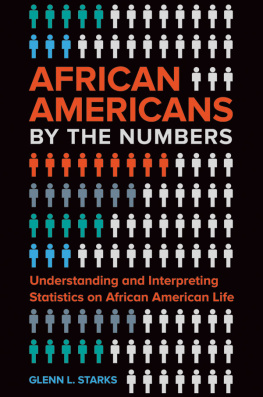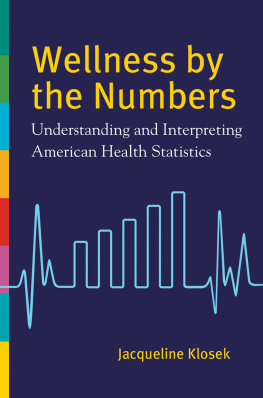African Americans by the Numbers
African Americans by the Numbers
Understanding and Interpreting Statistics on African American Life
Glenn L. Starks

Copyright 2017 by ABC-CLIO, LLC
All rights reserved. No part of this publication may be reproduced, stored in a retrieval system, or transmitted, in any form or by any means, electronic, mechanical, photocopying, recording, or otherwise, except for the inclusion of brief quotations in a review, without prior permission in writing from the publisher.
Library of Congress Cataloging-in-Publication Data
Names: Starks, Glenn L., 1966 author.
Title: African Americans by the numbers : understanding and interpreting
statistics on African American life / Glenn L. Starks.
Description: Santa Barbara, California : Greenwood, ABC-CLIO, LLC, 2017. |
Includes bibliographical references and index.
Identifiers: LCCN 2017010831 (print) | LCCN 2017021279 (ebook) |
ISBN 9781440845055 (ebook) | ISBN 9781440845048 (alk. paper)
Subjects: LCSH: African AmericansPopulationStatistics. |
African AmericansStatistics.
Classification: LCC E185.615 (ebook) | LCC E185.615 .S73 2017 (print) |
DDC 305.896/073021dc23
LC record available at https://lccn.loc.gov/2017010831
ISBN: 978-1-4408-4504-8
EISBN: 978-1-4408-4505-5
21 20 19 18 171 2 3 4 5
This book is also available as an eBook.
Greenwood
An Imprint of ABC-CLIO, LLC
ABC-CLIO, LLC
130 Cremona Drive, P.O. Box 1911
Santa Barbara, California 931161911
www.abc-clio.com
This book is printed on acid-free paper 
Manufactured in the United States of America
Contents
Education data is divided by levels. These include the following:
- Early childhood (or prekindergarten) education
- Primary (or elementary) school
- Middle (or junior high) school
- Secondary (or high) school
- Postsecondary (college, career, or technical schools) education
Some studies may aggregate data into more discrete categories, such as primary education representing grades kindergarten through 12 (notice this does not include preschool or day care); college education, including those with an associate and bachelors degree; and graduate education, including those with a masters degree and PhD. Care must be taken to understand how education level is defined for each study used. There is a difference between the classification of students who actually completed each level (e.g., some high school means a person attended but did not actually graduate from high school, and some college means some courses were taken but a degree was not obtained).
Education data generally outlines those who have completed high school or obtained a high school equivalency, for example, passed the General Educational Development (GED) test. Data also outlines those who are enrolled in college, completed some college courses, or have actually obtained at least a bachelors degree. For students in college, data may be distinguished by those with or pursuing an associate degree (e.g., in community college), bachelors degree, or an advanced degree. Data that shows the number or percentage of those with a bachelors or higher means those that have a bachelors, masters, or doctoral degree or hold a professional degree required for their profession, for example, juris doctor (JD) for lawyers or doctor of medicine (MD) for doctors.
Search for data dictionaries used to arrive at education statistics. For example, the National Center for Education Statistics provides a comprehensive glossary of terms used in its survey materials (National Center for Education Statistics 2016). They also provide data definitions as an appendix to many of their major reports.
Educational achievement is a primary indicator of economic and social well-being, as well as health disparities. For example, those with lower levels of education have less knowledge of the value of healthful living habits as well as regular medical care. They thus suffer health disparities in comparison to those with more formal education. It is not only an indicator of ones ability to obtain stable employment at a competitive wage, but it also influences ones propensity to commit crimes, vote, and generally be able to successfully advance in most facets of society. African Americans have made tremendous strides in educational achievement, particularly since the end of segregation. The education gap between blacks and whites has narrowed, particularly at the high school and undergraduate levels. Historically, black colleges and universities continue to play a primary role; 33% of all blacks who have bachelors degrees, 75% of blacks who have PhDs, 46% of black business executives, 50% of black engineers, 80% of black federal judges, and 50% of black doctors and lawyers in the United States have graduated from these schools. However, challenges still exist, such as black students scoring lower than their peers on standardized tests, disparities in discipline, the existence of the school-to-prison pipeline, and the continued existence of segregated schools.
shows the educational achievement of persons over 25 years of age in 2014 by race and Hispanic origin. The rates of high school completion are comparable across all races, with African Americans actually having the highest rate of completion at 30% (compared to the national average of 26.7%). However, the disparity for African Americans is apparent as the level of educational achievement increases. At the bachelors degree level, only 10.3% of blacks hold a degree, compared to 16.4% of non-Hispanic whites and 24.3% of Asians. Hispanics have the lowest rate at 8.1%. African Africans fall behind whites and Asians for masters degrees, and for PhDs, only 0.8% hold a degree compared to 2% of non-Hispanic whites and 4.1% of Asians. This data is a primary indicator of why African Americans earn less than their white and Asian counterparts and lag in other related areas such as home ownership.
It is very important to point out that there is a disparity also between black males and black females, as the latter have the higher rate of educational achievement. For example, McDaniel et al. (2011) analyzed 60 years of education data by race and sex to conclude, At no point did a larger proportion of black men complete college than black women. Less than 1% of black men earned a college degree in 1940, compared with less than 2% of black women. By 2000, approximately 10% of black men and 15% of black women completed college. Blacks rates of college completion have steadily risen over time, but more rapidly for women than for men. For blacks, women have held a consistent advantage in college completion over men for more than 70 years; for whites, womens advantage in college completion emerged in recent decades. Karl Reid (2013) reported the same conclusions in The Journal of Negro Education, pointing out that black males only comprise 4% of the total college enrollment. As far as actual degrees attained, black women earned 55% of all bachelors degrees conferred to African Americans in 20082009, as well as the majority of all masters and nonprofessional doctoral degrees. This education gap was supported by only 33% of black men graduating within six years, compared to 44% of black women and 57% of white males.












